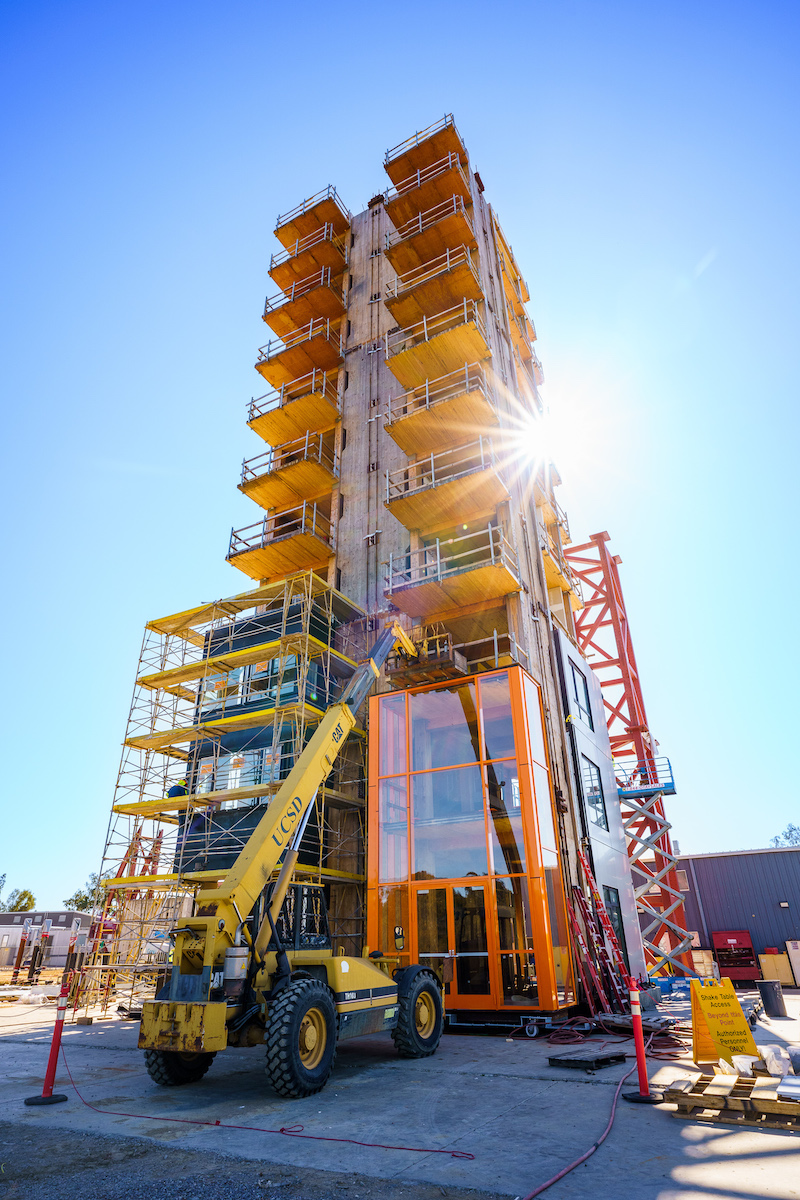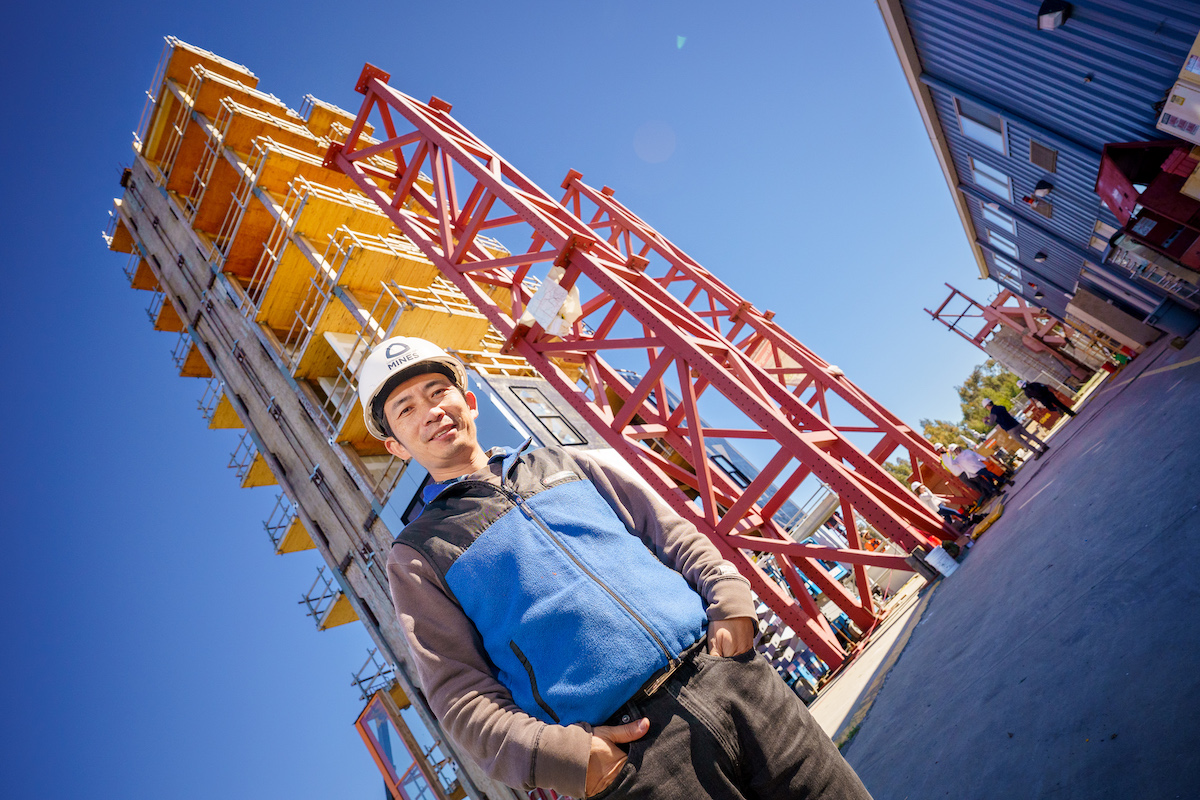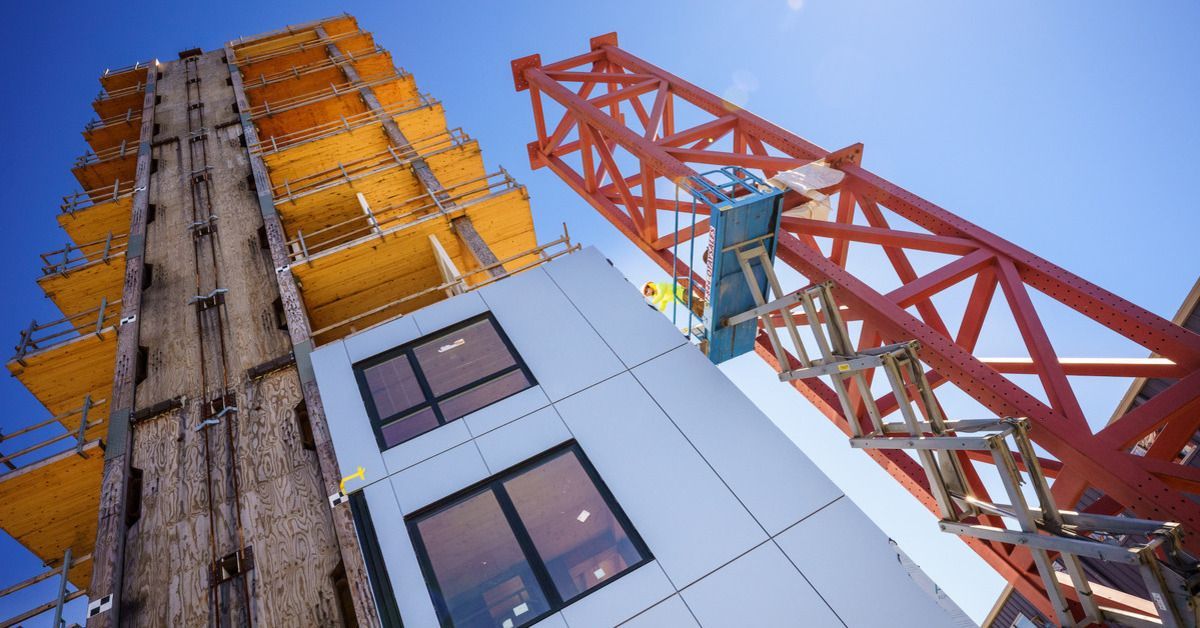Tallest Full-scale Building Ever Built on an Earthquake Simulator Put to the Test at UC San Diego
The tests will take place this spring at the UC San Diego NSF-funded outdoor shake table, now one of the two largest shake tables in the world.
Story by:
Media contact:
Published Date
Story by:
Media contact:
Share This:
Article Content
A 10-story building made of cross-laminated timber will be tested on one of the world’s two largest earthquake simulators at the University of California San Diego this spring. Known as the Tallwood project, it is the tallest full-scale building ever to be constructed and tested on an earthquake simulator, or shake table.
The tests are scheduled to start in late April. The shake table will simulate earthquake motions recorded during prior earthquakes covering a range of earthquake magnitudes on the Richter scale, from magnitude 4 to magnitude 8, including various iterations of the 6.7 magnitude Northridge earthquake which struck Los Angeles in 1994 . This will be done by accelerating the table to at least 1g, which could accelerate the top of the building to as much as 3gs. For reference, on average, modern roller coasters produce 4g of peak acceleration.
The shake table can carry and shake structures weighing up to 2000 metric tons, or 4.5 million pounds–roughly the weight of 1300 sedan cars. This makes it the earthquake simulator capable of carrying the largest payload in the world. It’s also the only large-scale earthquake table in the world located outdoors.
The table was recently upgraded thanks to $17 million in NSF funding and is now able to reproduce the full 3D ground motions that occur during earthquakes, when the ground is moving in all six degrees of freedom — longitudinal, lateral, vertical, roll, pitch and yaw. It is part of NSF’s Natural Hazards Engineering Research Infrastructure network, or NHERI–eight experimental facilities support innovative research for mitigating damage caused by hazards such as earthquakes, tsunamis, landslides, wind storms, storm surge, and flooding.
“The combination of largest payload capacity in the world, an outdoor setting, and the newly added six-degrees-of-freedom shaking capability make the UC San Diego shake table a powerful and unique facility,” said Joel Conte, principal investigator of the NSF funded UC San Diego NHERI shake table upgrade as well as operation and maintenance projects and a professor in the Department of Structural Engineering at the UC San Diego Jacobs School of Engineering. “It’s the only place where the Tallwood tests could happen.”
The Tallwood building was built at full-scale, meaning that it is indeed 10 stories tall, topping off at 116 feet, or about 35.5 meters—roughly one–fifth of the height of the National Monument in Washington, D.C.
The series of tests is funded by the National Science Foundation, as is the UC San Diego facility, located at the Englekirk Structural Engineering Center.

Photo: David Baillot/UC San Diego Jacobs School of Engineering
Mass timber building
Buildings made of mass timber — layers of wood bonded together — are gaining popularity as greener and faster alternatives to concrete and steel structures. With new building codes recently updated to permit more high-rise mass-timber buildings to be constructed in the United States, many have questioned how such buildings would fare in earthquakes.
“Mass timber is part of a massive trend in architecture and construction, but the seismic performance of tall buildings made with these new systems is not as well-understood as other existing building systems,” said Shiling Pei, principal investigator and associate professor of civil and environmental engineering at Colorado School of Mines.
Pei’s team, which includes both researchers and practitioners, designed a 10-story tall, mass timber rocking wall lateral system suitable for regions with high earthquake hazard. This new system is aimed at resilient performance, which means the building will have minimal damage from design level earthquakes and be quickly repairable after rare earthquakes.
“The rocking wall system basically consists of a solid wood wall panel anchored to the ground using steel cables or rods with large tension forces in them,” Pei said. “When exposed to lateral forces, the wood wall panels will rock back and forth — which reduces earthquake impacts — and then the steel rods will pull the building back to plumb once the earthquake passes.”

Stairs, windows and other non-structural components
Due to this seismic movement induced by the rocking system, resilience-critical nonstructural components within and covering the building, such as the exterior facade, interior walls and stairways, are in for a big ride.
“Resilient design must also account for the building’s nonstructural systems, which are not part of the structural load-resisting system, but play an important role in the building’s function and its ability to recover after the earthquake,” said Keri Ryan, a project co-investigator and engineering professor at the University of Nevada, Reno.
The project team led by Ryan will focus on safety-critical nonstructural components that span floor-to-floor and thus are subjected to the relative movement between stories. The building features four exterior façade assemblies, a number of interior walls, and a 10-story stair tower. The performance of the stairs will be assessed by a team led by Professor Tara Hutchinson, in the UC San Diego Department of Structural Engineering.
The exterior envelope must protect the building from temperature extremes and weather events, while stairs must remain functional to allow occupants to safely exit and first responders to continually access all floors of the building. “These assemblies have been designed with a variety of new and innovative details that are intended to accommodate the floor-to-floor movement without damage,” Ryan said. “Many of these details have never been tested in a rigorous building setting.”
In 2017, Pei’s team carried out a test on a two-story mass timber building by simulating shaking from the Northridge Earthquake, a magnitude 6.7 earthquake that struck Los Angeles in 1994. The building was subjected to 13 earthquake tests and remained structurally damage-free. In addition to demonstrating that mass timber building systems can be seismically resilient, those tests helped the research team develop the design and analysis methods that have been used for the 10-story building. The tests were carried out before the shake table was upgraded, and was only able to move in one degree of freedom.
The project is supported by the National Science Foundation (grants 1636164, 1635363, 1635227, 1634628, 1634204, 1635156). A consortium of universities are collaborating through NSF support on the NHERI TallWood project, including Colorado School of Mines (lead), University of Nevada, Reno, Colorado State University, University of Washington, Washington State University, University of California San Diego, Oregon State University, and Lehigh University. The project also received support from U.S. Forest Service, Forest Products Laboratory, and a number of industrial partners. The NHERI shake table facility operates through NSF support under cooperative agreement 2227407.
A photo of Pei on the construction site in August 2022 is available here (credit David Baillot/University of California San Diego). A photo of the site under construction in October 2022 is available here (credit Shiling Pei/Colorado School of Mines). A site rendering is available here (credit LEVER Architecture). Additional photos, renderings and videos are available upon request.
Share This:
You May Also Like
Stay in the Know
Keep up with all the latest from UC San Diego. Subscribe to the newsletter today.




